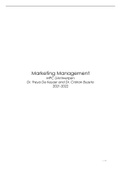Marketing Management
MPC UAntwerpen
Dr. Freya De Keyzer and Dr. Cristian Buzeta
2021-2022
,Table of contents
Part 1: Fundamentals of marketing........................................................................................................ 3
Chapter 1: Marketing & the organization ............................................................................................3
Chapter 2: The Marketing Environment ..............................................................................................7
Chapter 3: Consumer Behavior .......................................................................................................10
Chapter 6: Marketing Analytics & research........................................................................................20
Chapter 7: Market Segmentation & positioning .................................................................................32
Part 2: Creating customer value .......................................................................................................... 39
Chapter 8: Value through brands .....................................................................................................39
Chapter 9: Value through service .....................................................................................................46
Chapter 12: Value through pricing ...................................................................................................49
Part 3: Communicating & delivering customer value ............................................................................. 59
Chapter 13: Integrated marketing communications............................................................................59
Chapter 14: Mass Marketing Communications..................................................................................67
Chapter 15: Direct Marketing Communications.................................................................................73
Chapter 16: Digital Marketing & Media ............................................................................................75
Chapter 17: Distribution & Channel Management .............................................................................77
Part 4: Marketing planning and strategy .............................................................................................. 85
Chapter 18: Marketing planning ......................................................................................................85
Chapter 19: Analyzing competitors...................................................................................................92
Chapter 20: Product strategy: lifecycle, portfolio & growth..................................................................97
Chapter 22: Managing Marketing implementation, organization & control ........................................101
Guest lecture Thorsten Strauss - Introduction to growth hacking ........................................................... 107
Guest lecture – ALPRO ..................................................................................................................... 119
, Part 1: Fundamentals of marketing
Chapter 1: Marketing & the organization
1 Quotes: defining marketing
Marketing is the process by which companies create value for customers and build strong customer
relationships in order to capture value from customers in return.
- (Kotler & Armstrong, 2010)
Marketing is the activity, set of institutions, and processes for creating, communicating, delivering, and
exchanging offerings that have value for customers, clients, partners, and society at large.
- (American Marketing Association, 2017)
1.1 Defining marketing
Value
- For customers’ needs and wants
- For organizations: profit (financial, societal, environmental, ...)
Customer
- Customer satisfaction is central for success
Relationship
- Long-term goals vs. short-term goals
- Acquisition vs. retention
Process
- Stream of exchanges
ð Marketing is central for business success
1.1.1 The marketing concept
2 Marketing is not …
Some businesses do not practice marketing (i.e., the customer satisfaction ideal) at all.
- They (intentionally) engage in cheating, swindling, deceiving, or cynically manipulating
customers in some way.
- Naturally, this produces dissatisfaction.
This orientation be considered (bad examples of) commerce, exchange, selling, or “business”—as well
as cheating, swindling, and so on—but it is not marketing.
ð Real marketing has nothing to do with “bad business practices”
, 3 Market or product orientation?
3.1 Market orientation
Potential Marketing
Customer
market products & Customers
needs
opportunities services
3.2 Product orientation
Production Manufacture Aggressive
Customers
capabilities product sales effort
ð The customers’ satisfaction = KEY in marketing
o Therefore, we need to know their needs
o Keep in mind that production marketing orientation is not a good marketing
strategy (The customer needs to be central = marketing orientation).
§ E.g.: NMBS and SONY
3.2.1 Understanding Market-Driven Businesses
3.3 Efficiency ó effectiveness
- Efficient: input must be higher than output,
doing things right
o Efficient tools, best ways to reach your
clients etc.
- Effective: doing the right things





